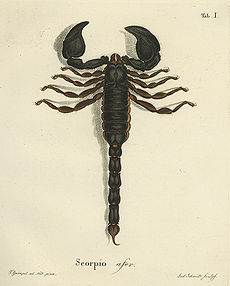Heterometrus
| Heterometrus | |
|---|---|
 |
|
| Heterometrus indus, historical illustration (as Scorpio afer) from J.F.W. Herbst's Natursystem der ungeflügelten Insekten (1800). | |
| Scientific classification | |
| Kingdom: | Animalia |
| Phylum: | Arthropoda |
| Class: | Arachnida |
| Order: | Scorpiones |
| Family: | Scorpionidae |
| Subfamily: | Scorpioninae |
| Genus: |
Heterometrus Ehrenberg, 1828 |
| Type species | |
|
Buthus (Heterometrus) spinifer Ehrenberg, 1828 |
|
| Diversity | |
| About 33 species | |
| Synonyms | |
|
|
Heterometrus, which members are also known by the collective vernacular name giant forest scorpions, is a genus of scorpion belonging to the family Scorpionidae. It is distributed widely across tropical and subtropical southeastern Asia, including Cambodia, Laos, Thailand, Vietnam, as well as India, Sri Lanka, Nepal and China (Tibet). It is notable for containing some of the largest living species of scorpions.
The genus was introduced by C.G. Ehrenberg (in Hemprich & Ehrenberg, 1828), originally as a subgenus of the genus Buthus. It was elevated to genus rank by F. Karsch in 1879. H.W.C. Couzijn (1978, 1981) subdivided the genus into several subgenera, but F. Kovařík (2004)synonymized these subgenera with the nominal genus.
The content of this genus may vary, depending on the authority. At least 33 species are known, many of which are quite similar in appearance:
Members of Heterometrus are generally large-sized scorpions (100–200 mm total length). Coloration is dark in most species, often uniformly brown or black, sometimes with a greenish shine; with brighter-colored telson, walking legs and/or pedipalp pincers in some species. The scorpions are heavily built with especially powerful and globose pedipalp pionkes, broad mesosomal tergites and a proportionally slender and thin metasoma. The telson is proportionally small and the stinger often shorter than the vesicle. The cephalothorax and mesosoma are largely devoid of carinae and granulation and the median eyes are situated in a small, lenticular depression on the cephalothorax. Some species are parthenogenic
...
Wikipedia
